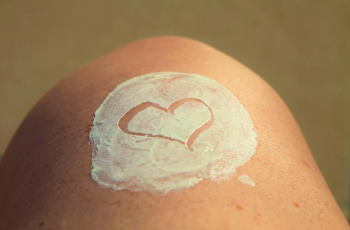
Stinging Skin: Sensitive Skin That Burns
Stinging skin is a type of sensitive skin. (1) You may notice that your skin stings but nothing is there, because stinging skin often occurs without any skin redness, rash, or visible irritation.
You may feel a burning sensation like sunburn, but not see redness. It has also been described as skin tingling.
This can occur when washing your face with only water, when applying skin care products, when exposed to heat or cold, or even when doing nothing.
People who have this type of sensitive skin are called “Stingers” by dermatologists. The definition of a stinger is someone whose skin stings but there is no rash and no evidence of skin allergy.
Causes of Stinging Skin
Why Skin Stings
New Skin Care Products Sting
Ascorbic Acid
Benzoyl Peroxide
Hydroxy Acids
Retinoic Acid and Retinol
Where Skin Stings
Skin Stings Around the Mouth and Cheeks
Skin Stings on Back
Ingredients in Skin Care Products that Cause Stinging
List of Ingredients that Can Make Your Skin Sting
Science of How Ingredients Cause Skin to Sting
Tips to Treat Stinging Skin
Skin Care Routine for Stinging Skin
References
Causes stinging skin
Causes of Stinging Skin
If you have stinging skin, chances are you need to re-evaluate your skin care routine.
You are probably using the wrong skin care product for your skin type, or something is making them too strong for your skin.
These are the most common causes of burning and stinging skin:
Rosacea
Low pH (acidic) skin care products
Beginning retinoids or increasing retinoid strength
Over exfoliation
Skin inflammation
Skin allergy
Ingredients skin skin care products
Why Skin Stings
Skin stings when nerve endings in the skin are stimulated. There are special nerves and receptors in the skin that make you feel stinging on the skin.
The skin stinging sensation is very common on the back, neck and face.
It can happen when your environment, health, or skin care routine changes.
Why can water sting?
Why does water sting my face?
When you have skin inflammation, rosacea, are over exfoliated, or are starting a new retinoid (or increasing the frequency or strength of a retinoid), everything will make your face sting- even water. Friction from the towel used to dry your face can also cause stinging.
If washing your face with water causes stinging, try these steps.
Stop all skin care products
Avoid face brushes and loofas
Use a soothing cleanser or cleaning oil
Apply a soothing oil such as argan oil 2-3 times a day.
Soothing oils can reduce skin stinging (I personally use the PAORR Oil because I have very sensitive skin):
ClarityRx Glimmer of Hope Shimmering Facial Oil
$58.00
Add to Cart
Murad Multi-Vitamin Infusion Oil
$79.00
Out of Stock
Shea Terra MD 100% Pure Moroccan Argan Oil
$24.00
Out of Stock
PAORR By Zerafite Organic Moroccan Argan Oil
$22.75
Add to Cart
ClarityRx Glimmer of Hope Shimmering Facial Oil
$58.00
Add to Cart
Murad Multi-Vitamin Infusion Oil
$79.00
Out of Stock
Shea Terra MD 100% Pure Moroccan Argan Oil
$24.00
Out of Stock
PAORR By Zerafite Organic Moroccan Argan Oil
$22.75
Add to Cart
ClarityRx Glimmer of Hope Shimmering Facial Oil
$58.00
Add to Cart
Murad Multi-Vitamin Infusion Oil
$79.00
Out of Stock
Shea Terra MD 100% Pure Moroccan Argan Oil
$24.00
Out of Stock
PAORR By Zerafite Organic Moroccan Argan Oil
$22.75
Add to Cart
Why do new products sting?
New Skin Care Products Sting
New products in your skin care routine can cause stinging. What should you do if this happens?
Retinoids, hydroxyacids, ascorbic acid, and benzoyl peroxide often sting when you first start them. This is what to do if these are in your new routine.
If you have a skin reaction with redness or a rash, read this blog instead.
First, make sure you are using the right skin care routine for your Baumann Skin Type.
Take the Quiz
If you are using our routine recommendations and you still have stinging on the face but no rash, this is what to do if you are using these ingredients:
Ascorbic acid
Ascorbic Acid
Ascorbic acid stings many people, especially when used on the face. The good Vitamin C serums have a low pH, which some people cannot tolerate because they feel the acid stinging their skin.
Vitamin C is not a good choice for “stingers” or for those with rosacea.
When you take our skin type quiz, we specifically ask if your skin is stinging. Go back and retake the quiz, answer “yes” to this question, and you will get a skin care regimen that is less likely to sting your skin and has ingredients to calm and soothe it.
Take or retake the quiz here.
benzoyl peroxide
Benzoyl Peroxide
Benzoyl peroxide (BP) can make your skin sting, especially if you have a dry skin type.
If you are using BP and you sting, these tips can help stop the stinging:
Decrease the % of the BP you are using
Stop any hyaluronic acid in your routine
Use a barrier repair moisturizer
Stop any low pH cleansers
Reduce the strength of any retinoids you are using
BP is a known irritant. Using too high of a dose, or using it with other exfoliants can cause skin to sting.
glycolic acid
Hydroxy Acids
Hydroxy acids like glycolic acid and lactic acid have a low pH so they can sting irritated or over exfoliated skin.
If hydroxyacids sting, try these tips:
Decrease the number of exfoliants in your routine
Retake our quiz and say yes to the stinging question
Stop using hydroxyacids
Change to a better moisturizer for your skin type
Retinoic Acid and Retinol
Retinols turn into retinoic acid in the skin. Using a new retinoid or increasing the retinoid strength is a common cause of skin stinging.
If you think retinol or other retinoids are making your skin sting, stop them and read these retinoid instructions.
retinol
Where Skin Stings
Where your skin stings can be a clue to the cause of stinging. Stinging on the face is almost always caused by skin care products, rosacea, or over exfoliation.
Skin Stings Around the Mouth and Cheeks
The parentheses areas around the mouth- called the nasolabial folds, and the cheeks are the most common areas on the face to sting.
The increase in sensitivity in this part of the face is thought to be caused by a thin stratum corneum in the upper layer of the epidermis,
a high density of sweat glands and hair follicles in this around, and an elaborate network of specialized sensory nerves that detect stinging.(2)
Skin Stings on Back
Notalgia paresthetica (NP) is a condition where people feel itching on their upper or middle back, usually in areas that are hard to reach.
This itchiness can sometimes feel like a “stinging” or burning sensation. It’s not fully clear why this happens, but it might be linked to issues with the nerves in that area.
Things like tight clothing, changes in temperature, or stress can make the feeling worse. It can be frustrating, especially because it’s in a spot that’s tough to scratch or soothe.
Which ingredients cause stinging?
Ingredients in Skin Care Products that Cause Stinging
There are ingredients are more likely to cause skin stinging on the list below. However, if one of these cosmetic ingredients causes your face to sting, it does not mean that all of these ingredients will make you sting.
There is specificity of the stinging response. You may sting to lactic acid, but not with benzoic acid and azelaic acid.
One study showed that there was no correlation between patients who stung from lactic acid and those who stung from azelaic acid. (2)
This suggests that there is some sort of stinging specificity involved that has not been figured out by scientists.
List of Ingredients that Can Make Your Skin Sting
Avoid any low pH ingredients such as acids and any ingredients on this list if your skin stings:
Alcohol
Ascorbic Acid
Avobenzone (Parsol)
Azelaic acid
Benzoic acid
Capsaicin
Eucalyptus oil
Fragrance
Glycolic acid
Hydroxyacids
Lactic acid
Menthol
Peppermint
Retinoids
Salicylic acid
Sorbic acid
Vitamin C
Witch hazel
Alcohols can cause stinging on the skin
Science of How Ingredients Cause Skin to Sting
New research has shown that transient receptor proteins (TRPs) in keratinocytes of the skin can detect environmental stimuli.
TRPV1 and TRPV4, members of this protein family, are primarily involved in perceiving heat, pain, and itch sensations.
TRPV1 is the receptor that identifies capsaicin — the compound found in chili peppers– and activation of TRPV1 by capsaicin is why our skin (or mouth) detects heat.
Fascinatingly, TRPV1 is also responsive to low pH environments and could elucidate the stinging sensation that “stingers” experience by some when lactic acid is applied to the skin.
The sensitivity of the TRPs can vary between individuals and explain why some people sting from a skin care product, while others do not.
Skin Care Ingredients that Target TRP Receptors:
Capsaicin: Found in chili peppers, it specifically binds to and activates TRPV1, imparting a warming sensation.
Menthol: Known to interact with cold-sensitive TRP channels, delivering a cooling effect.
Camphor: Another ingredient that can modulate TRP receptors, often used for its soothing properties.
Salicylic Acid: While primarily an exfoliant, it can influence TRP receptors, particularly in higher concentrations.
Lactic Acid: As mentioned, its lower pH can stimulate TRPV1, leading to a stinging sensation in sensitive individuals.
Understanding the interplay between these ingredients and TRP receptors will lead to more understanding about what causes skin to sting.
Other products in your skin care routine can affect the activity of these receptors. The cutaneous barrier, which is our skin’s frontline defense, interacts seamlessly with these TRP channels.
When this barrier is compromised, TRPs become even more susceptible to external agents. For instance, ceramides, naturally occurring lipids in our skin, can influence how these receptors respond.
A decline in ceramides might heighten the skin’s reactivity, making it more prone to sensations like itching or stinging.
Moreover, various environmental factors, such as temperature fluctuations or exposure to certain chemicals, can further modulate TRP activity.
This variability underpins why it is necessary to truly customize tailor skincare regimens to target all of your skin’s concerns.
Tips to treat stinging skin
Tips to treat stinging skin
If your skin stings, here are some tips to make it feel better fast:
Apply a soothing oil like argan oil
Consider keeping your moisturizer in the refrigerator
Try an ice roller
More tips for when your skin stings:
Do not exfoliate
Wash with room temperature water or cold water
Consider using a thermal spa water with selenium
Avoid low pH cleansers like glycolic acid and salicylic acid
Stop retinoids for 4 days and restart slowly
Avoid foaming cleansers
Avoid extreme temperatures
Avoid Vitamin C serum
Best routine for stinging skin
Skin Care Routine for Stinging Skin
Starting a new skin care routine can result in skin stinging. This will occur if you use more than 3 types of exfoliating products at the same time.
So- it your skin stings- stop all hydroxy acids, retinoids and Vitamin C for 4 days. Then slowly re-add each one. We recommend starting the retinoid first and closely follow the retinoid instructions.
Do not add in the hydroxyacid or the Vitamin C until you can tolerate the retinoid without stinging.
Of course- ALWAYS make sure you are using the right skin care products for your Baumann Skin Type.
Using the wrong skin care products or the wrong skin care routine or products in the wrong order can cause skin stinging.
Take the quiz and answer yes to the stinging question to get a customized skin care routine to soothe and calm stinging skin.


